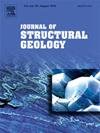Lesser Himalayan thrusting followed by out-of-sequence channel flow in the Greater Himalayan Sequence, north-western Garhwal Himalaya, India: evidence from integrated structural and microtectonic studies
IF 2.9
2区 地球科学
Q2 GEOSCIENCES, MULTIDISCIPLINARY
引用次数: 0
Abstract
In continent-continent collision zones, the mechanically weak, hot middle crust plays a significant role in the accommodation of convergence between the colliding plates. Thus, multiple tectonothermal episodes are preserved in the middle crust represented in general, by the metamorphic core of collisional orogens like the Himalaya. The present study demonstrates that the Greater Himalayan Sequence (GHS) evolved by mid-crustal channel flow that is out-of sequence with respect to the penetrative fabric forming event in the Paleoproterozoic Lesser Himalayan Sequence (LH) occurring SSW of the GHS, northwestern Garhwal Himalaya, India. Structural and microtectonic studies reveal three phases of deformation at varying thermal regimes across the Himalayan Metamorphic Core (HMC) that constitutes the GHS, the Main Central Thrust (MCT) and the Paleoproterozoic LH, south of the MCT. Out-of-sequence deformation in the LH-GHS package is revealed by the prevalence of the earlier D1 related structures in the Paleoproterozoic LH, and their gradual transposition and reorientation parallel to the late D2 ductile thrusts preserved in the hinterland part (GHS). Crystallographic preferred orientation studies suggest that the GHS extruded as a mid-crustal channel evinced by reversal in the asymmetry of mid-crustal flow across the GHS. SSW-ward extrusion of the GHS as a mid-crustal channel involved a significant pure-shear component (41–66 %) of deformation in transport-parallel section. Fluid infiltration along the MCT was pre-to syn-kinematic with respect to its localized thrust-sense reactivation.
印度加尔瓦尔-喜马拉雅西北部大喜马拉雅层序小喜马拉雅逆冲后的层序外河道流动:综合构造和微构造研究的证据
在大陆-大陆碰撞带,机械弱、热的中地壳对碰撞板块之间的收敛起着重要的调节作用。因此,以喜马拉雅等碰撞造山带的变质核为代表的中地壳保留了多个构造热期。本文的研究表明,大喜马拉雅层序(GHS)是由发生在印度加尔瓦尔喜马拉雅西北部大喜马拉雅层序南西侧的古元古代小喜马拉雅层序(LH)的渗透构造形成事件的中地壳通道流演化而成的。构造和微构造研究揭示了喜马拉雅变质核(HMC)在不同热状态下的三个变形阶段,包括GHS,主中央逆冲(MCT)和MCT以南的古元古代LH。LH-GHS包体的序外变形主要表现在LH古元古代早期D1相关构造的普遍存在,并与内陆部分(GHS)保存的晚D2韧性冲断平行逐渐转位和重新定向。结晶学的优选取向研究表明,GHS是作为一个中地壳通道挤出的,其表现为中地壳流动在GHS上的不对称性的逆转。作为中地壳通道的GHS向ssw方向挤压,在运输平行剖面中产生了重要的纯剪切变形分量(41% ~ 66%)。沿着MCT的流体浸润相对于其局部的推力感觉再激活是预同步的。
本文章由计算机程序翻译,如有差异,请以英文原文为准。
求助全文
约1分钟内获得全文
求助全文
来源期刊

Journal of Structural Geology
地学-地球科学综合
CiteScore
6.00
自引率
19.40%
发文量
192
审稿时长
15.7 weeks
期刊介绍:
The Journal of Structural Geology publishes process-oriented investigations about structural geology using appropriate combinations of analog and digital field data, seismic reflection data, satellite-derived data, geometric analysis, kinematic analysis, laboratory experiments, computer visualizations, and analogue or numerical modelling on all scales. Contributions are encouraged to draw perspectives from rheology, rock mechanics, geophysics,metamorphism, sedimentology, petroleum geology, economic geology, geodynamics, planetary geology, tectonics and neotectonics to provide a more powerful understanding of deformation processes and systems. Given the visual nature of the discipline, supplementary materials that portray the data and analysis in 3-D or quasi 3-D manners, including the use of videos, and/or graphical abstracts can significantly strengthen the impact of contributions.
 求助内容:
求助内容: 应助结果提醒方式:
应助结果提醒方式:


